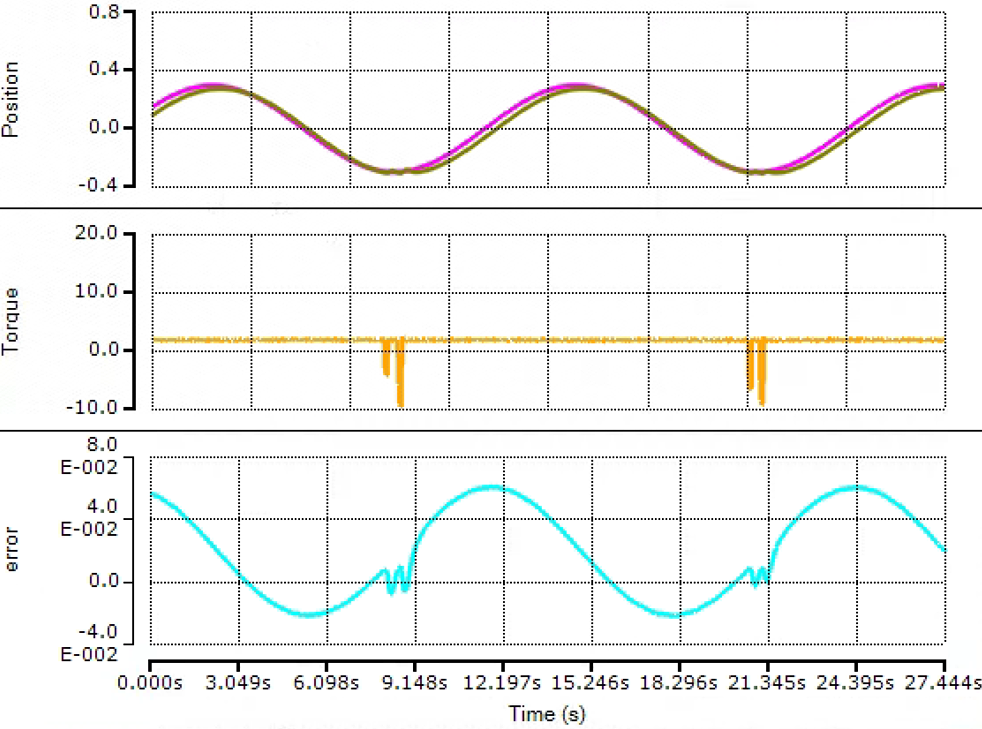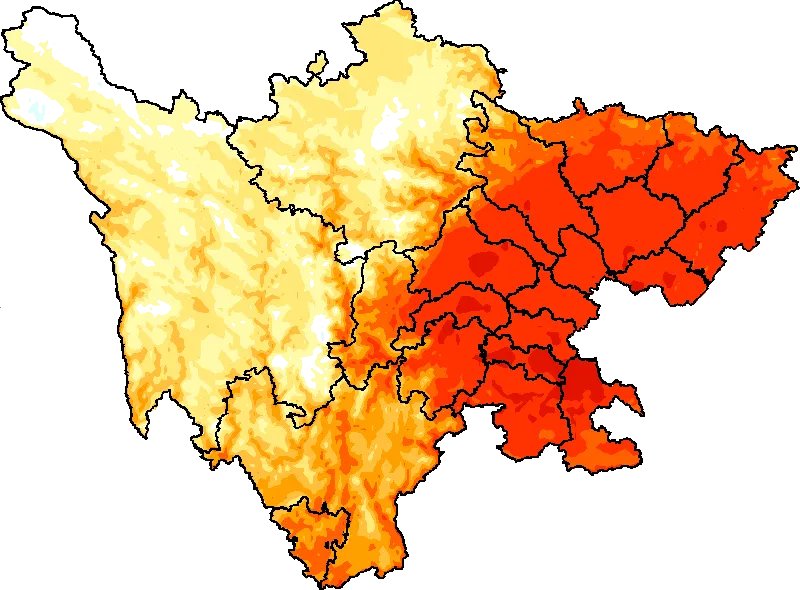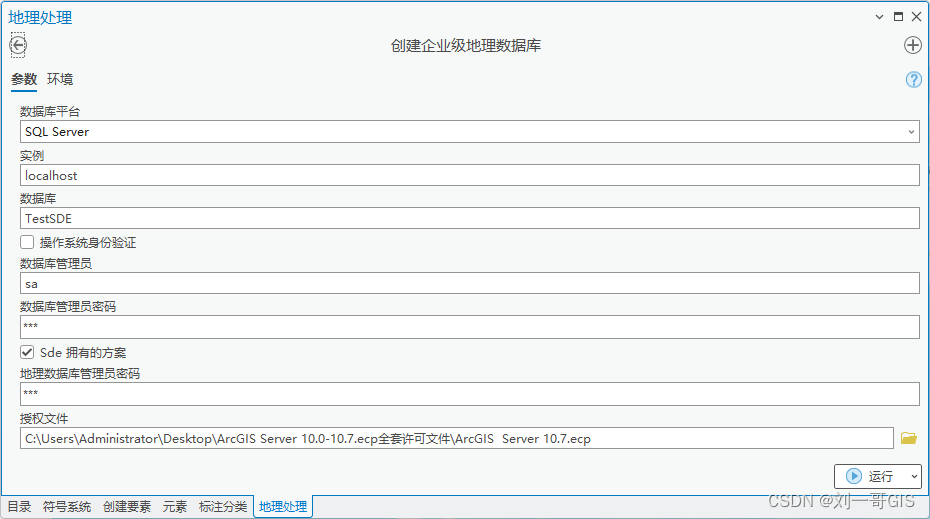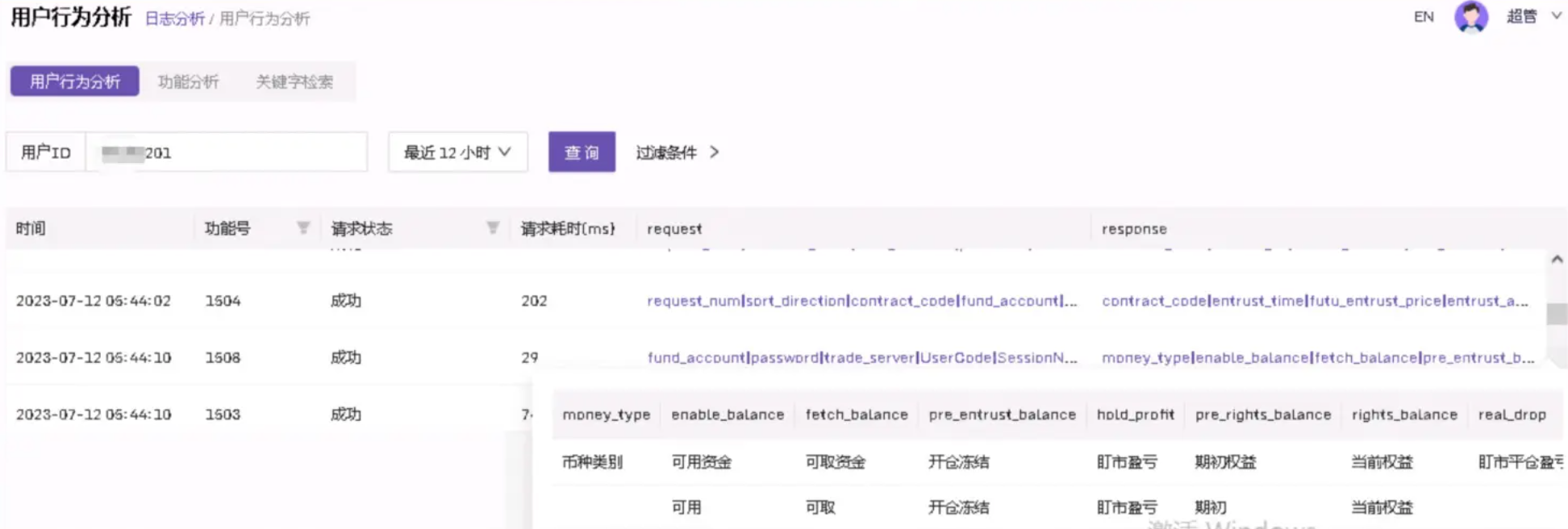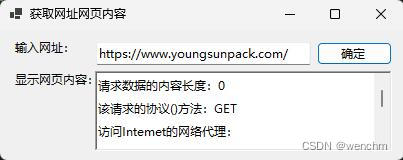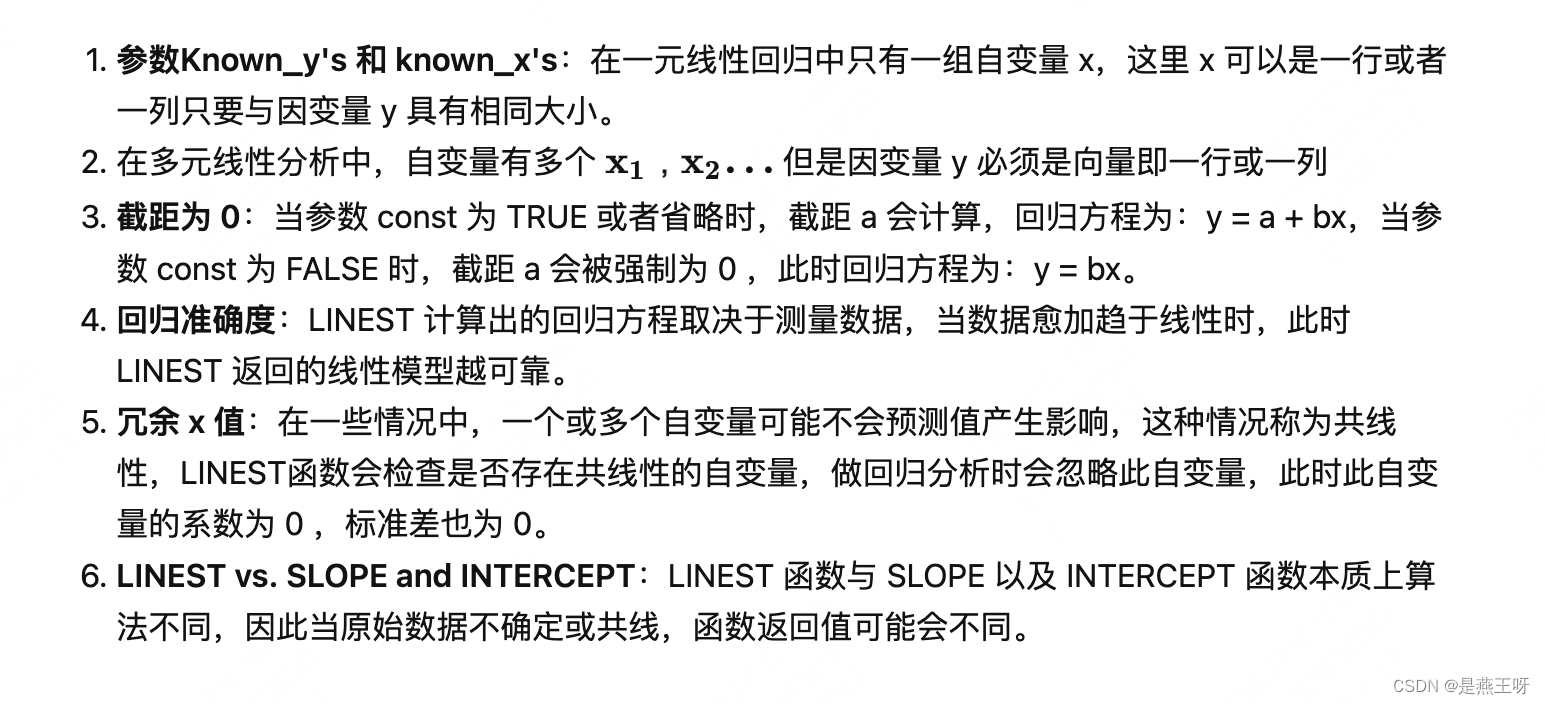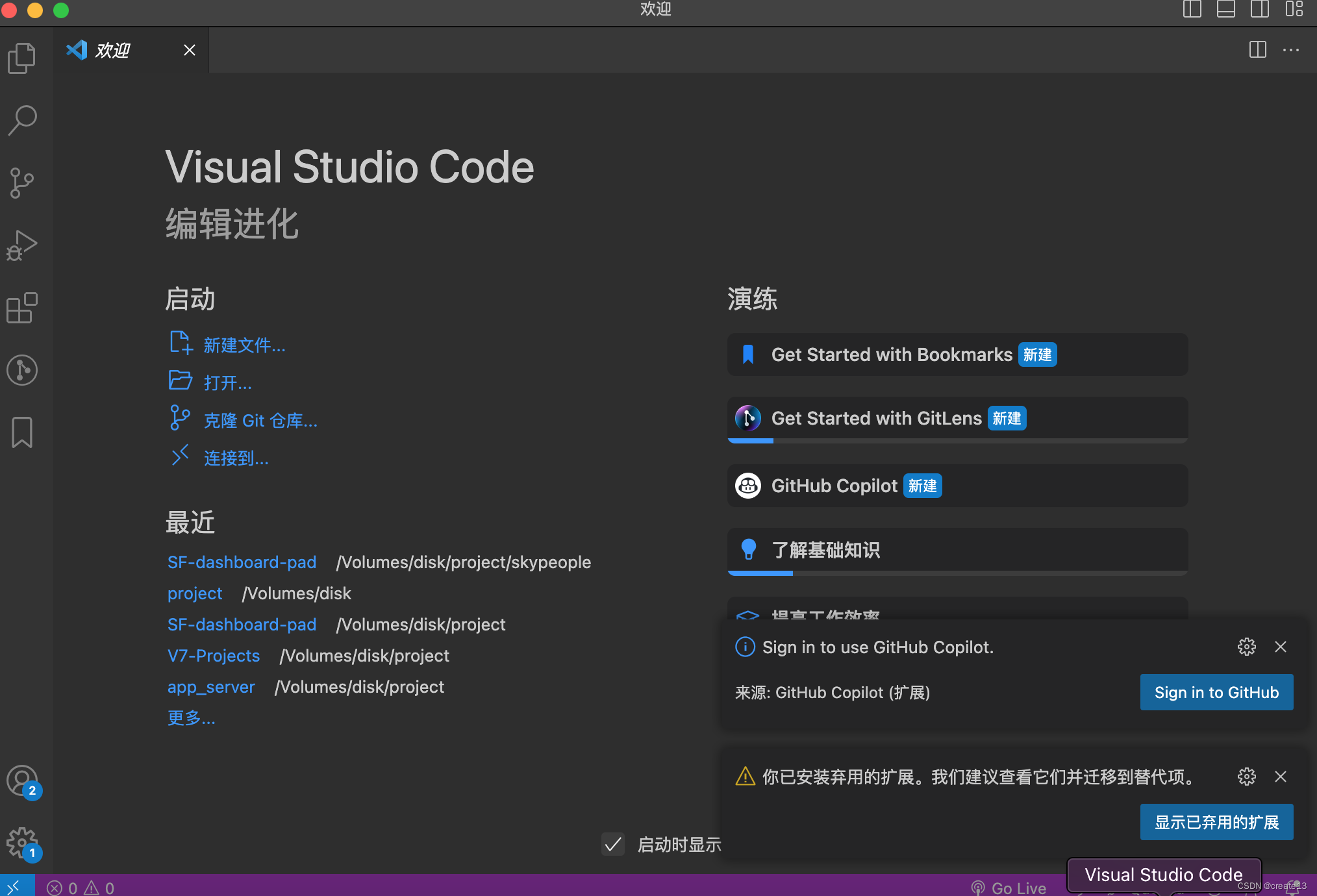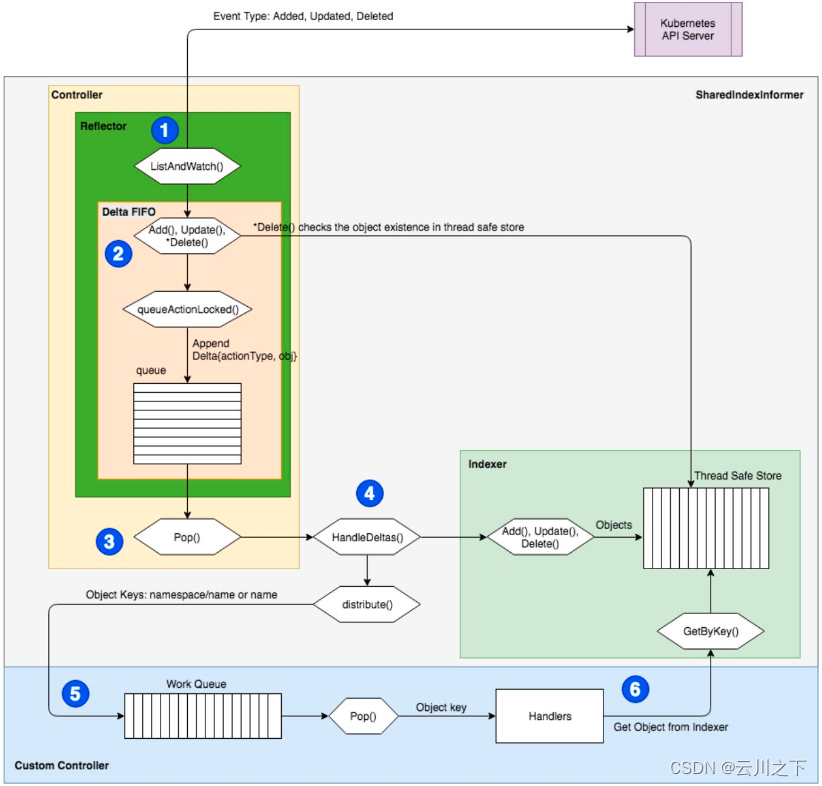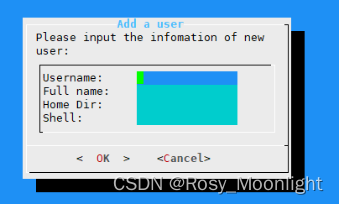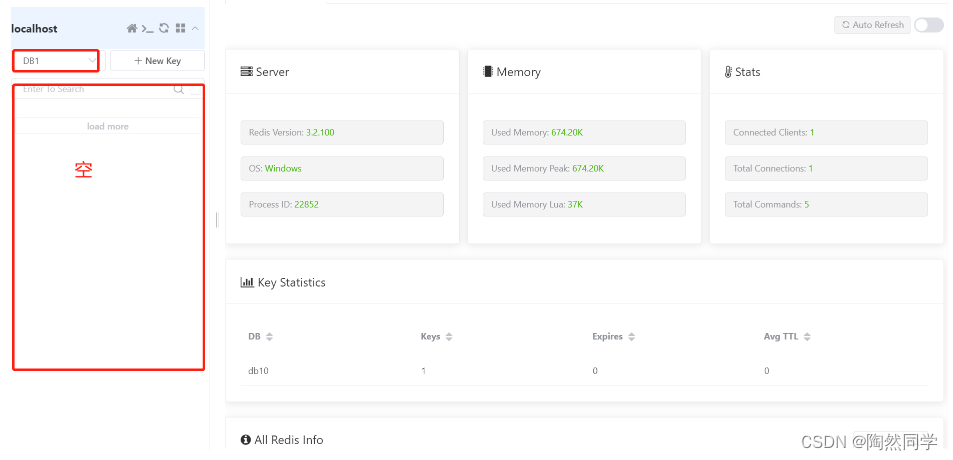1. 栈(Stack)
1.1 概念
栈:一种特殊的线性表,其只允许在固定的一端进行插入和删除元素操作。进行数据插入和删除操作的一端称为栈 顶,另一端称为栈底。栈中的数据元素遵守后进先出LIFO(Last In First Out)的原则。
压栈:栈的插入操作叫做进栈/压栈/入栈,入数据在栈顶。
出栈:栈的删除操作叫做出栈。出数据在栈顶。



1.2 栈的使用

从上图中可以看到,Stack继承了Vector,Vector和ArrayList类似,都是动态的顺序表,不同的Vector是线程安全;Vector类,是线程安全的动态数组,但是性能较差 , 现在已经不是很常用了 , 可以说已经过时了。
常用方法
| 方法 | 功能 |
| Stack() | 构造一个空的栈 |
| E push(E e) | 将e入栈,并返回e |
| E pop() | 将栈顶元素出栈并返回 |
| E peek() | 获取栈顶元素 |
| int size() | 获取栈中有效元素个数 |
| boolean empty() | 检测栈是否为空 |
public static void main(String[] args) {
Stack<Integer> s = new Stack();
s.push(1);
s.push(2);
s.push(3);
s.push(4);
System.out.println(s.size()); // 获取栈中有效元素个数---> 4
System.out.println(s.peek()); // 获取栈顶元素---> 4
s.pop(); // 4出栈,栈中剩余1 2 3,栈顶元素为3
System.out.println(s.pop()); // 3出栈,栈中剩余1 2 栈顶元素为3
if(s.empty()){
System.out.println("栈空");
}else{
System.out.println(s.size());
}
}1.3 栈的模拟实现

从上图中可以看到,Stack继承了Vector,Vector和ArrayList类似,都是动态的顺序表,不同的是Vector是线程安 全的。
代码实现
1. 构造方法
class MyStack{
private int[] arr;
// size 记录栈中元素个数
private int size;
public MyStack(){
// 调用无参构造方法 默认最大容量12
this(12);
}
public MyStack(int MaxSize){
this.arr = new int[MaxSize];
}
}
2. 入栈(push)
// 入栈
public int push(int value){
if(this.size == arr.length){
// 栈满 ,需要扩容
int[] copyArr;
// 复制arr 数组并扩容一倍
copyArr = Arrays.copyOf(arr,2 * arr.length);
arr = copyArr;
}
//将元素添加到size位置
this.arr[size] = value;
// 元素个数加一
this.size++;
// 返回添加元素
return value;
}
3. 出栈(pop)
// 出栈
public int pop(){
if(this.size == 0){
//没有元素
//抛出运行时异常,此处也可以自定义异常
throw new RuntimeException("栈中没有元素,不能出栈....");
}
// 获得栈顶元素
int value = this.arr[size - 1];
// size - 1 之后, 下一次插入时会覆盖原数据,利用覆盖替代删除
this.size--;
return value;
}
4.获取栈顶元素(peek)
// 获取栈顶元素
public int peek(){
if(this.size == 0){
//没有元素
//抛出运行时异常,此处也可以自定义异常
throw new RuntimeException("栈中没有元素,不能出栈....");
}
return this.arr[this.size - 1];
}
5.获取元素个数(getSize)
//获取元素个数
public int getSize(){
return this.size;
}
6.判断栈是否为空(isEmpty)
//判断元素是否为空
public boolean isEmpty(){
return this.size == 0;
}
完整代码
import java.util.Arrays;
public class MyStack{
private int[] arr;
// size 记录栈中元素个数
private int size;
public MyStack(){
// 调用无参构造方法 默认最大容量12
this(12);
}
public MyStack(int MaxSize){
this.arr = new int[MaxSize];
}
// 入栈
public int push(int value){
if(this.size == arr.length){
// 栈满 ,需要扩容
int[] copyArr;
// 复制arr 数组并扩容一倍
copyArr = Arrays.copyOf(arr,2 * arr.length);
arr = copyArr;
}
//将元素添加到size位置
this.arr[size] = value;
// 元素个数加一
this.size++;
// 返回添加元素
return value;
}
// 出栈
public int pop(){
if(isEmpty()){
//没有元素
//抛出运行时异常,此处也可以自定义异常
throw new RuntimeException("栈中没有元素,不能出栈....");
}
// 获得栈顶元素
int value = this.arr[size - 1];
// size - 1 之后, 下一次插入时会覆盖原数据,利用覆盖替代删除
this.size--;
return value;
}
// 获取栈顶元素
public int peek(){
if(isEmpty()){
//没有元素
//抛出运行时异常,此处也可以自定义异常
throw new RuntimeException("栈中没有元素,不能出栈....");
}
return this.arr[this.size - 1];
}
//获取元素个数
public int getSize(){
return this.size;
}
//判断元素是否为空
public boolean isEmpty(){
return this.size == 0;
}
}
1.4 栈的应用场景
1. 改变元素的序列
1. 若进栈序列为 1,2,3,4 ,进栈过程中可以出栈,则下列不可能的一个出栈序列是( )
A: 1,4,3,2 B: 2,3,4,1 C: 3,1,4,2 D: 3,4,2,1
根据栈先进后出的性质,结合题目中进栈的过程中也可以出栈,如A选项:1进1出,2进3进4进,4出3出2出即符合题意,同理C选项,1进2进3进3出之后不可能直接出1,故C选项不可能实现。
2.一个栈的初始状态为空。现将元素1、2、3、4、5、A、B、C、D、E依次入栈,然后再依次出栈,则元素出栈的顺 序是( )。
A: 12345ABCDE B: EDCBA54321 C: ABCDE12345 D: 54321EDCBA
先进后出,依次入栈,依次出栈,故B选项合理
2. 将递归转化为循环
递归实现逆序打印
public void display(ListNode head){
if(head == null){
return;
}
//直到链表末尾,再归回去
if(head.next == null){
System.out.println(head.val+" ");
return;
}
display(head.next);
System.out.println(head.val+" ");
}使用栈实现逆序打印
public void display(ListNode head){
if(head == null){
return;
}
Stack<ListNode> stack = new Stack<>();
ListNode cur = head;
while(cur!= null){
stack.push(cur);
cur = cur.next;
}
while(!stack.empty()){
ListNode ret = stack.pop();
System.out.println(ret.val+" ");
}
}2. 队列(Queue)
2.1 概念
队列:只允许在一端进行插入数据操作,在另一端进行删除数据操作的特殊线性表,队列具有先进先出FIFO(First In First Out)
入队列:进行插入操作的一端称为队尾(Tail/Rear)
出队列:进行删除操作的一端称为队头 (Head/Front)
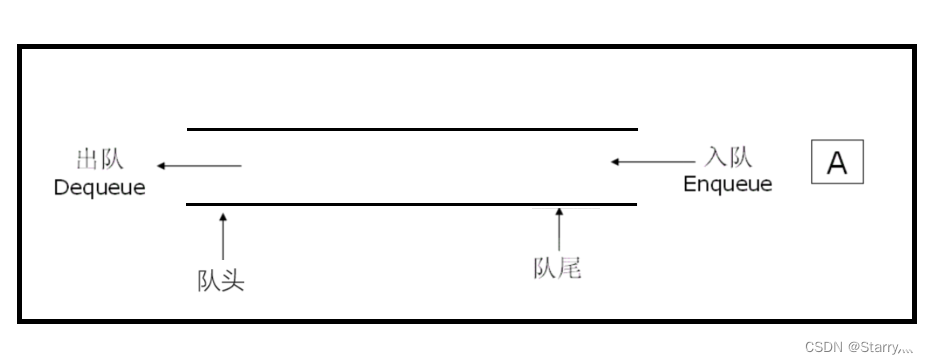
2.2 队列的使用
在Java中,Queue是个接口,底层是通过链表实现的。
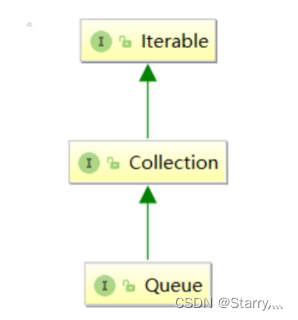
| 方法 | 功能 |
| boolean offer(E e) | 入队列 |
| E poll() | 出队列 |
| peek() | 获取队头元素 |
| int size() | 获取队列中有效元素个数 |
| boolean isEmpty() | 检测队列是否为空 |
注意:Queue是个接口,在实例化时必须实例化LinkedList的对象,因为LinkedList实现了Queue接口。
public static void main(String[] args) {
Queue<Integer> q = new LinkedList<>();
q.offer(1);
q.offer(2);
q.offer(3);
q.offer(4);
q.offer(5); // 从队尾入队列
System.out.println(q.size());
System.out.println(q.peek()); // 获取队头元素
q.poll();
System.out.println(q.poll()); // 从队头出队列,并将删除的元素返回
if(q.isEmpty()){
System.out.println("队列空");
}else{
System.out.println(q.size());
}
}
2.3 队列模拟实现
队列中既然可以存储元素,那底层肯定要有能够保存元素的空间,通过前面线性表的学习了解到常见的空间类型有两种:顺序结构和链式结构 。
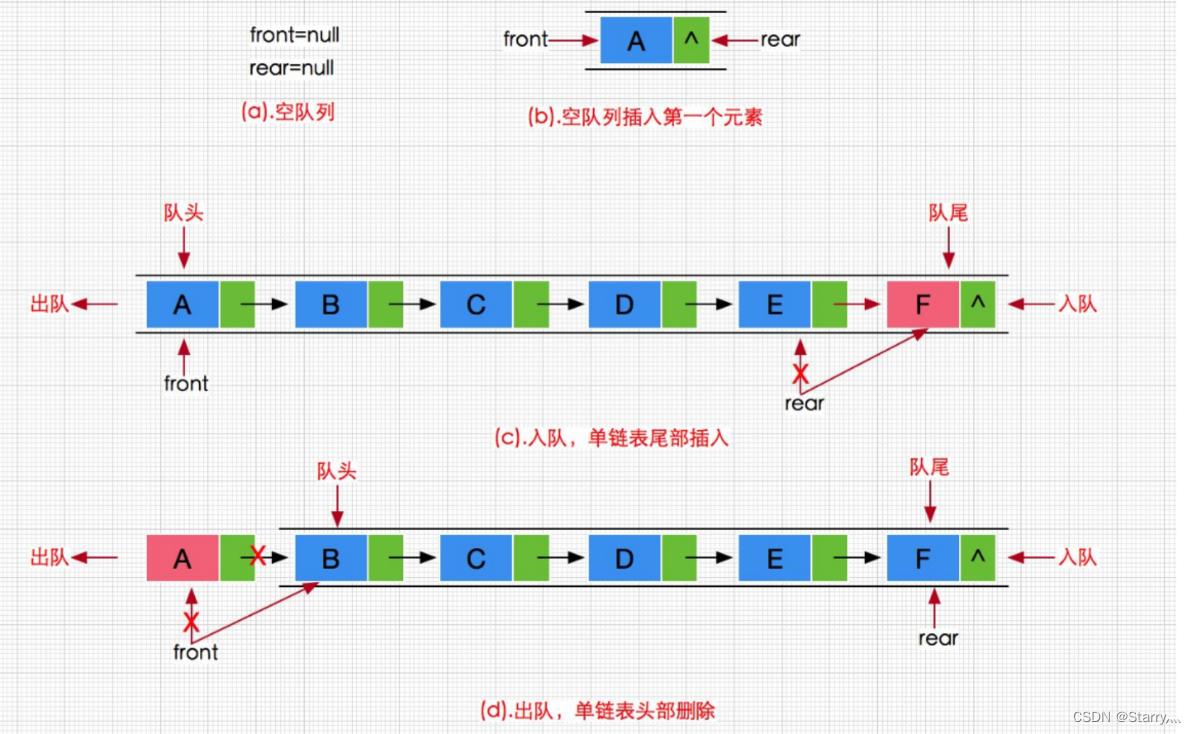
public class Queue {
// 双向链表节点
public static class ListNode{
ListNode next;
ListNode prev;
int value;
ListNode(int value){
this.value = value;
}
}
ListNode first; // 队头
ListNode last; // 队尾
int size = 0;
// 入队列---向双向链表位置插入新节点
public void offer(int e){
ListNode newNode = new ListNode(e);
if(first == null){
first = newNode;
// last = newNode;
}else{
last.next = newNode;
newNode.prev = last;
// last = newNode;
}
last = newNode;
size++;
}
// 出队列---将双向链表第一个节点删除掉
public int poll(){
// 1. 队列为空
// 2. 队列中只有一个元素----链表中只有一个节点---直接删除
// 3. 队列中有多个元素---链表中有多个节点----将第一个节点删除
int value = 0;
if(first == null){
return null;
}else if(first == last){
last = null;
first = null;
}else{
value = first.value;
first = first.next;
first.prev.next = null;
first.prev = null;
}
--size;
return value;
}
// 获取队头元素---获取链
public int peek(){
if(first == null){
return null;
}
return first.value;
}
public int size() {
return size;
}
public boolean isEmpty(){
return first == null;
}
}2.4 循环队列
实际中我们有时还会使用一种队列叫循环队列。如操作系统课程讲解生产者消费者模型时可以就会使用循环队列。环形队列通常使用数组实现。

数组下标循环的小技巧
1. 下标最后再往后(offset 小于 array.length): index = (index + offset) % array.length
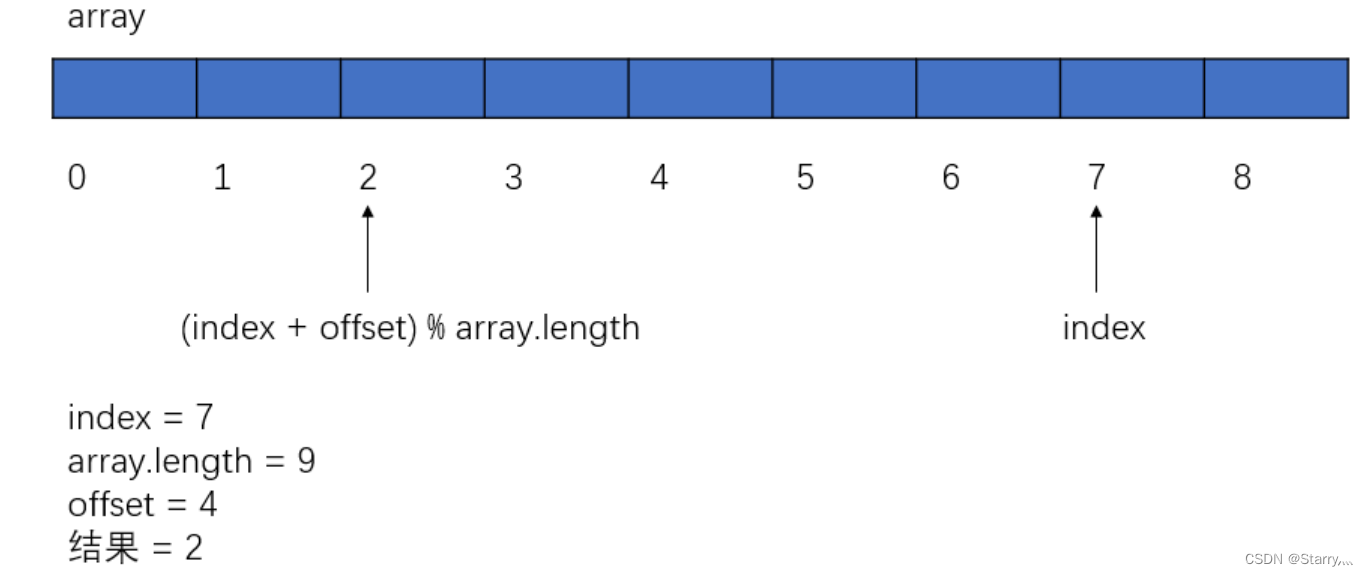
2. 下标最前再往前(offset 小于 array.length): index = (index + array.length - offset)%array.length

如何区分空与满
1. 通过添加 size 属性记录
2. 保留一个位置
3. 使用标记
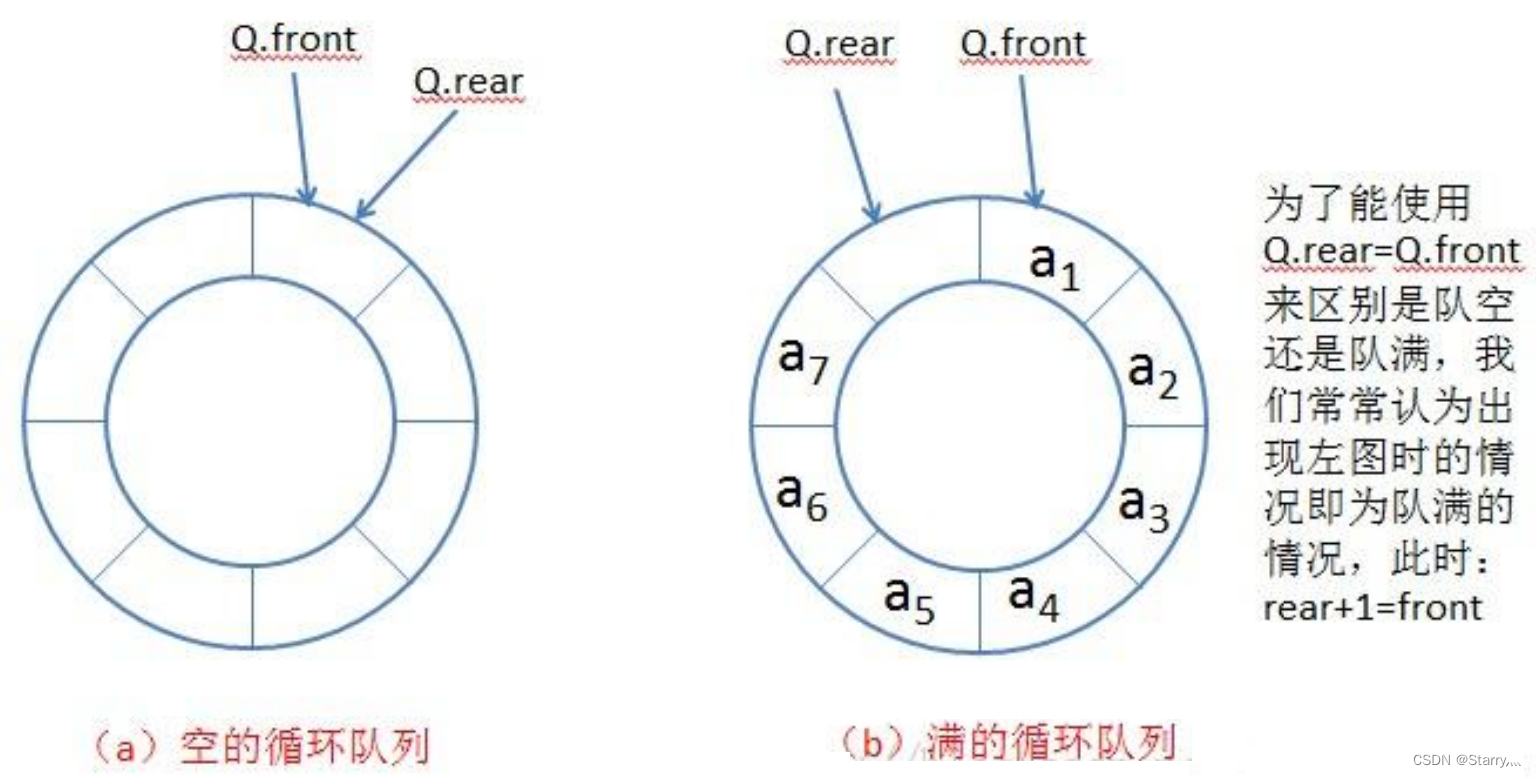
public class CircularQueue {
private int front;
private int rear;
private int[] circle;
public CircularQueue(int k) {
//浪费掉一个存储空间
circle = new int[k+1];
}
//入队列
public boolean enQueue(int value) {
if (isFull()) {
return false;
}
circle[rear] = value;
//因为是循环队列,不能写++,要以取模的方式
rear = (rear + 1) % circle.length;
return true;
}
//出队列
public boolean deQueue() {
if (isEmpty()) {
return false;
}
front = (front + 1) % circle.length;
return true;
}
//返回队头元素
public int Front() {
if (isEmpty()) {
return -1;
}
return circle[front];
}
//返回队尾元素
public int Rear() {
if (isEmpty()) {
return -1;
}
return circle[(rear - 1 + circle.length) % circle.length];
}
public boolean isEmpty() {
return rear == front;
}
public boolean isFull() {
return ((rear + 1) % circle.length) == front;
}
}
3. 双端队列 (Deque)
双端队列(deque)是指允许两端都可以进行入队和出队操作的队列,deque 是 “double ended queue” 的简称。那就说明元素可以从队头出队和入队,也可以从队尾出队和入队。

Deque是一个接口,使用时必须创建LinkedList的对象。
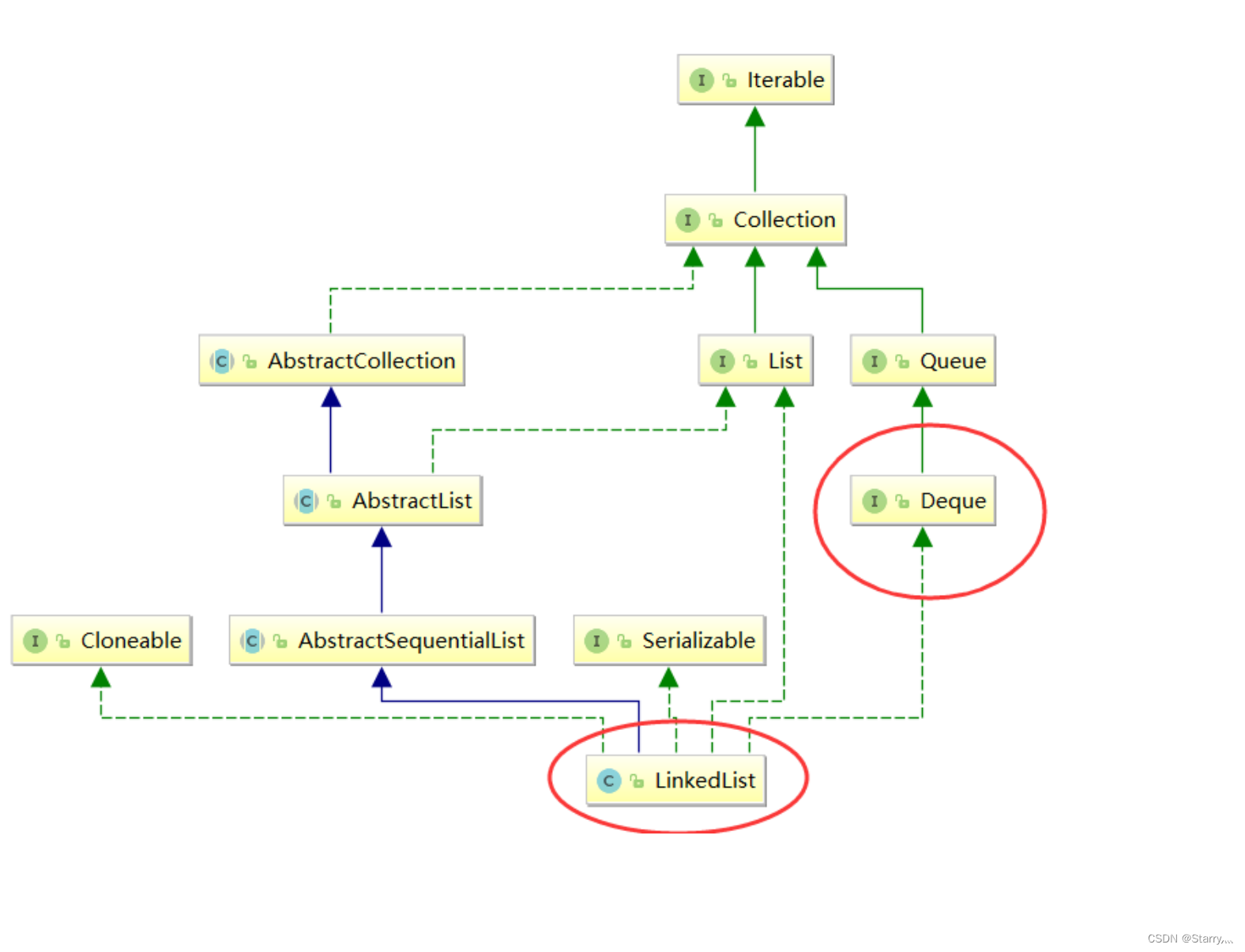
在实际工程中,使用Deque接口是比较多的,栈和队列均可以使用该接口。
Deque<Integer> stack = new ArrayDeque<>();//双端队列的线性实现
Deque<Integer> queue = new LinkedList<>();//双端队列的链式实现
4. 栈和队列的互相实现
用栈实现队列:
class MyQueue {
public Stack<Integer> stack1;
public Stack<Integer> stack2;
public MyQueue() {
stack1 = new Stack<>();
stack2 = new Stack<>();
}
public void push(int x) {
stack1.push(x);
}
public int pop() {
if (stack2.isEmpty()) {
in2out();
}
return stack2.pop();
}
public int peek() {
if (stack2.isEmpty()){
in2out();
}
return stack2.peek();
}
public boolean empty() {
return stack1.isEmpty() && stack2.isEmpty();
}
private void in2out() {
while (!stack1.isEmpty()) {
stack2.push(stack1.pop());
}
}
}用队列实现栈:
class MyStack {
Queue<Integer> queue1;
Queue<Integer> queue2;
public MyStack() {
queue1 = new LinkedList<Integer>();
queue2 = new LinkedList<Integer>();
}
public void push(int x) {
queue2.offer(x);
while (!queue1.isEmpty()) {
queue2.offer(queue1.poll());
}
Queue<Integer> temp = queue1;
queue1 = queue2;
queue2 = temp;
}
public int pop() {
return queue1.poll();
}
public int top() {
return queue1.peek();
}
public boolean empty() {
return queue1.isEmpty();
}
}


